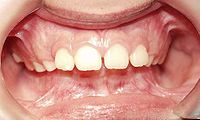Classification of Orthodontic Anomalies
(Redirected from Classification of orthodontic anomalies)
Sagittal plane:
Vertical plane:
Transversal plane:
Angle Classification[edit | edit source]
- The mesiobuccal cusp of the maxillary first molar lies in the mesiobuccal groove of the mandibular first molar, but the other teeth may have other anomalies such as spacing, crowding, open bite etc.
- Is also called Distocclusion, or Mandibular Retrognathism
- The mesiobuccal cusp of the upper molar is situated anterior to the mesiobuccal groove
- Two subdivisions exist:
- Division 1 (II/1) --> Anterior teeth protrude, increased overjet
- Division 2 (II/2) --> Central incisors are retroclined and sometimes the lateral incisors are seen to overlap the centrals
- Is also called Mandibular Prognathism
- The mesiobuccal cusp of the upper molar lies posterior to the mesiobuccal groove of the first mandibular molar
Overjet[edit | edit source]
- Is the distance between the tip of the upper and the tip of the lower incisors in the horizontal plane
- The normal distance is ~ 1.5-2.5 mm
- We distinguish two types of overjet:
- Positive overjet --> Distance >2.5 mm
- Negative overjet (anterior cross bite) --> Distance <1.5 mm
Overbite[edit | edit source]
Normally the upper centrals should cover between 1/3 - 1/4 of the anterior surface of the lower centrals
Any disturbance in this coverage can result in:
- Open Bite
- Deep Bite
Scissor Bite[edit | edit source]
- Is a rather rare orthodontic malocclusion, where the palatal surface of the upper molars rest laterally from the buccal surface of the mandibular molars
- Typical finding in Brodie syndrome
(Posterior) Cross Bite[edit | edit source]
In this malocclusion the buccal cusps of the upper molars lie in the opposing central fossa of the mandibular molars (in physiological conditions the palatal cusps of the upper molars lie in the opposing central fossa)
Midline Deviation[edit | edit source]
Occurs when the midline of the upper jaw doesn't coincide with that of the lower jaw
Other Orthodontic problems[edit | edit source]
- Crowding
Is the result of lack of space in the dental arch
- Spacing
Is the result of excess of space in the dental arch
Wide interdental spaces
- Diastema
Space between the two central incisors
- Rotation
The tooth is rotated in the longitudinal axis




